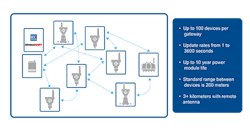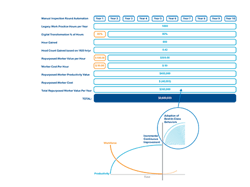Digital transformation initiatives are more effective when starting with a problem in mind as opposed to leading with technology. This practical approach provides concrete results, encouraging further investment due to positive early returns. The alternative — picking an intriguing technology and then imposing it on a problem — often leads to failure. This is especially true when dealing with a key concern at chemical plants: the time, expense and safety issues posed by manual inspection rounds.
Highly skilled and increasingly valuable plant personnel often must perform these mundane and repetitive tasks, moving through the site to check the status of instruments and assets, and documenting their findings using pen and paper. These results then get manually entered into some type of maintenance management system, a process prone to data entry errors.
Applying digital tools to automate manual rounds frees these personnel to do higher level tasks such as analyzing collected data to improve operations. (Such worker upskilling is an essential element in any successful digital transformation.) In addition, cutting the time staff spend in the field reduces their exposure to risks posed by the process environment.
Automated data collection provides more consistent, repeatable and accurate measurements and allows much faster update rates, say, every 15 minutes versus once-a-shift or longer with manual rounds. The far shorter period between updates can enable plant personnel to more quickly catch and respond to condition changes.
In the past, automation of manual rounds often was dismissed as too expensive, time consuming and disruptive. This was because each extra point of data collection required the addition of wired infrastructure to connect the instrument or asset to a host such as an asset management system.
Today, using wireless instead of wired instrumentation to gather and transmit data can cut costs and time for connecting each point by up to 75%. Wireless instrumentation enables plants to automate most manual rounds, enabling data gathering even for lower value and less critical assets that never could justify traditional signal wiring.
Artificial intelligence, machine learning and other advanced digital automation technologies won’t produce the desired results when fed bad or incomplete information, making the timely delivery of accurate data a necessity. High quality data from the field allow assets to effectively and continually signal their status. With such inputs, analytics can provide decision support, enabling data-driven work practices and improved efficiency.
This article will focus on the use of WirelessHART, the leading industrial wireless standard, to enable the automation of manual rounds. WirelessHART handles two-way communications between a wireless sensor and a host such as an asset management system (Figure 1).
Figure 1. WirelessHART uses a self-organizing mesh to cost-effectively gather inputs from field devices.
Assets To Monitor
An end user planning to switch from manual inspection to automated wireless monitoring should consider prioritizing those rounds found to be most risky during inclement conditions, such as ones in remote or elevated locations where slips and falls are a recurring source of safety reportable incidents. In addition, it should focus on automating data collection to provide clear-cut value. One common and compelling example is the monitoring of safety pressure relief valves (PRVs).
PRVs prevent overpressure conditions but, when actuated, may release hazardous pollutants into the nearby area. A plant must report these releases to the appropriate regulatory agency. If detection depends on a visible telltale signal, like a sock, that is inspected every eight hours, then the agency might assume the release lasted for eight hours. In contrast, an acoustic wireless transmitter (Figure 2) can provide 8-sec. update rates with long battery life, dramatically improving the timeliness of release reporting while also confirming the PRV has reseated and the release has stopped.
Safety and environmental bodies as well as insurance agencies often prompt compliance projects requiring more data from the field for monitoring purposes. In the case of PRVs, some environmental agencies no longer consider manual inspections acceptable and now mandate digital monitoring. After making a periodic inspection, an insurance underwriter may demand new monitoring points or secondary indication to mitigate risks related to asset health or worker exposure. In other cases, plantwide safety initiatives often require the automation of safety-related inspection rounds. Regardless of their source, compliance projects are mandatory, and wireless can dramatically reduce implementation cost and time.
Figure 2. Wireless acoustic monitoring device enables automatic remote monitoring.
In one application, an end user found the cost of wired PRV monitoring was $18,000/valve versus $3,000/valve with WirelessHART. Moreover, addition of the wired infrastructure only could take place during a turnaround whereas installation of wireless monitoring could occur during normal operations.
The project involved simply clamping a wireless acoustic monitoring device to the piping downstream of each PRV. All the devices were then joined to the WirelessHART gateway, which, in turn, was hardwired to the plant’s asset management system.
Getting Results
Data gathering is only the first step towards the digital transformation of manual rounds. An essential next step is generation of insights that can be used to ensure compliance, optimize maintenance and improve operations.
Simply aggregating data, including inputs from automated rounds, in a historian isn’t necessarily the best way to glean insights. Not all data types reside well in a data historian. So, operating companies sometimes resort to creating custom analytics, which can be cost- and knowledge-intensive. Furthermore, sorting through an ocean of data, much irrelevant to the topic of interest, takes an inordinate amount of time, negatively impacting worker efficiency.
A better alternative is enterprise asset monitoring software such as Emerson’s Plantweb portfolio of products. These integrate actionable information from multiple sources, organize such inputs around assets and assign criticality. The software also lets each user subscribe only to relevant information based on the person’s role within the company. Moreover, it works in conjunction with underlying asset-based analytics such as Emerson’s Plantweb Insight applications. Each asset-based analytics app focuses on a single asset type, greatly simplifying installation and use. Built-in algorithms provide answers to common questions and preconfigured graphics illustrate insights. Such apps cover many types of assets; for others, application of artificial intelligence and machine learning can lead to insights about data sets collected over long periods of time.
For example, a process engineer could subscribe to get information about an asset’s process conditions, along with alerts from asset-based analytics. Instrument and valve technicians could receive alarms and alerts from prioritized assets. A maintenance expert could examine condition monitoring data and create the necessary work orders directly from the enterprise asset monitoring software.
All these actions support the see, decide and act model. With this model, wired and wireless sensors see and supply real-time data to analytics software. This software empowers experts to decide upon the correct actions and then to direct proper personnel to act by performing any necessary tasks, from adjusting a setpoint to replacing a pump.
Getting Buy-In
Many workers worry that automation will make them irrelevant and, therefore, replaceable. However, most chemical plants already run extremely lean and would welcome ways to make current staff more productive. Automating manual rounds can help boost productivity by letting personnel focus on higher level activities. If workers know the digital transformation process will lead to their upskilling, they more likely will embrace automation and focus on productivity improvements.
Many plants commit so much time to manual inspection rounds that, when something breaks, rounds get suspended to free personnel to fix the problem — which, in turn, may place other assets at risk if their manual inspection interval doesn’t meet the bare minimum. This is the classic case where organizations are staffed to run but not staffed to improve work practices.
When deciding to automate manual rounds, the value creation frequently is based on the criticality of the asset. However, there’s a hidden and often neglected benefit. For example, it’s easy to calculate the value for condition monitoring of critical assets because these typically will achieve a reduction in maintenance costs of 30–40% annually. It’s a bit harder to see the savings associated with eliminating manual inspection rounds but Figure 3 is a good starting point.
Figure 3. Significant savings, some often unrecognized at first, accrue, enhancing return on investment.
Suppose manual inspection rounds consume one half of a worker’s time, say, 1,000 hr/yr. Evaluating cost savings purely from a worker-cost perspective gives a value for automating manual rounds of half the person’s total compensation. However, a more correct way to view the value of digital transformation is to evaluate based on the time the worker could spend on higher value activities. These productivity gains can help decision-makers and budget gatekeepers justify the cost of automating manual rounds.
In this case, if the person spends the now-freed 1,000 hours on higher value activities, then the true return on the investment (ROI) could amount to as much as $400,000 in productivity gains. This hidden value in productivity gains often is neglected when calculating ROI. Realizing these gains is why workforce upskilling is an essential component of digital transformation.
Calculating the repurposed worker value per hour can be difficult because different tasks have different values. The key is upskilling to maximum value by including worker efficiency gains, increases in production, improved overall equipment efficiency, reduced energy costs and mitigated environmental impact with fewer reportable safety incidents. This upskilling often requires investments in worker training in the areas of digital technologies — but these expenditures are well worthwhile to realize the cited benefits.
Not A Panacea
Even with wireless, most plants can’t afford to monitor everything and can’t anticipate every problem or every failure mode; this is especially true as process units and plants age. An experienced and knowledgeable field technician can hear, see, smell and feel what the process is like when it’s operating well and can sense when performance is degrading or failure is imminent. In some cases and for some types of problems, a good technician can identify issues almost impossible to spot with automated rounds.
In addition, many plants conduct manual rounds to check for safety issues, and so will be very reluctant to drop them. One major incident could wipe out years of savings from eliminating operator rounds, not to mention the potential of injuries and environmental damage. Because a technician is making rounds anyway, that person can record data at the same time, minimizing costs.
In such cases, targeted wireless monitoring and data analytics often can augment a worker’s knowledge base and improve that person’s inspections.
Digitalize Deftly
As organizations create digital transformation strategies to gain new efficiencies, they must take a holistic approach from data to analytics to action. Some end users have developed a strong vision and methodologies and can be considered digital transformers. Others are making progress as problem solvers by using digital technology for specific applications such as automating manual rounds. Still others are seeking technology to test but don’t yet have a plan. Regardless of where an organization is on its digital transformation journey, solutions are available to speed progress.
DAN CARLSON is a solution architect at Emerson Automation Solutions, Shakopee, Minn. Email him at [email protected].




